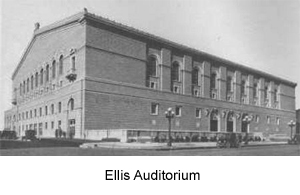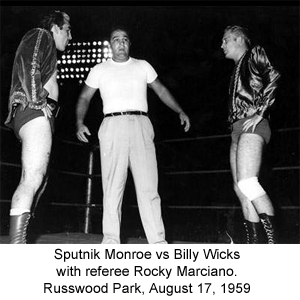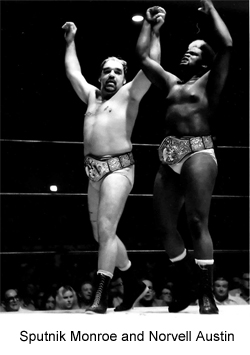|
 |
|
 |
|
Introduction:
During the
late sixties and seventies, my parents operated Droke
Furniture Company, located at 3526 Jackson Avenue in
Memphis. The store was a popular, mid-level retail
establishment that brought a lot of unique experiences and
interesting people into my childhood. There would be two
individuals that were semi-regulars to the store who would
help nurture my growing interest in the sport of
professional wrestling. One was on the road to fame while
the other’s fame had somewhat sadly diminished with time.
As a child,
I watched WHBQ-Channel 13’s Studio Wrestling on a
semi-regular basis. It wasn’t until a young wrestler named
Jerry Lawler appeared on the show that I became a devout
follower of the Memphis-based production. I first met
Lawler while he worked for West Memphis radio station KWAM
and performed promotional work for the furniture store.
When my uncle was tragically killed in an automobile crash
on my birthday in 1969, my parents had to leave town to make
arraignments for the funeral. That day, Lawler was at the
furniture store doing a remote broadcast in the station’s
mobile studio, a red, white & blue Volkswagen bus. I spent
the day with him in the bus, learning about life, music and
the art of broadcasting. Lawler aided me tremendously in
dealing with the shock of losing my uncle. I will always be
grateful to him for that.
When I
first saw Lawler wrestling on television, I was quite
surprised. I had lost track of him and had no idea that the
young artist turned broadcaster had been training to become
a wrestler. I was instantly mesmerized by his on-camera
remarks that were part-hyperbola / part-sarcasm. His quick,
acerbic wit took the art of the wrestling interview to a
whole new level. I don’t recall missing a Studio Wrestling
show for the next ten years. When Saturday morning
wrestling came on, everything else in the world was put on
hold.
The
furniture store would also serve as an introduction point
for another professional wrestler. However, this wrestler
would be from the sport’s glorious and rambunctious past.
Next door to the furniture store was a small used car lot
and when not busy, one of the salesmen would come over and
chat with my father. I had heard the car salesman’s name
mentioned a few time on wrestling but I didn’t really know a
whole lot about him. He was a chain-smoking, tough-talking,
bull of a man with some great stories about Memphis during
the fifties and sixties. He also had mannerisms and sayings
that I would liberally borrow from for use at school. I
would start off many a classmate conversation with his
phrase “Let me tell you idiots something….” My father’s car
salesman friend would on occasion charismatically state,
“often imitated but never duplicated.”
That
salesman’s name was Sputnik Monroe |
|
The History of
the Sport and Its Memphis Connection:
 Professional
wrestling came into existence during the late 1800's as a
boisterous mixture of carnival and Vaudeville. America's
Industrial Revolution and subsequent urbanization had
created an atmosphere that was ripe for amusement. The
turmoil and chaos of the Civil War had subsided and the
American public was now ready for entertainment. The first
professional wrestlers were carnival strongmen that would
wrestle anyone in the crowd willing to pay a small fee.
Soon, enterprising promoters began incorporating some of the
physical antics of Vaudeville into the strongmen's acts and
the sport of Professional Wrestling was born. Watch any
early Buster Keaton or Harold Lloyd film and you can see
these Vaudeville-trained actors perform many of the same
stunts that are the mainstay of today's World Wrestling
Entertainment superstars. Professional
wrestling came into existence during the late 1800's as a
boisterous mixture of carnival and Vaudeville. America's
Industrial Revolution and subsequent urbanization had
created an atmosphere that was ripe for amusement. The
turmoil and chaos of the Civil War had subsided and the
American public was now ready for entertainment. The first
professional wrestlers were carnival strongmen that would
wrestle anyone in the crowd willing to pay a small fee.
Soon, enterprising promoters began incorporating some of the
physical antics of Vaudeville into the strongmen's acts and
the sport of Professional Wrestling was born. Watch any
early Buster Keaton or Harold Lloyd film and you can see
these Vaudeville-trained actors perform many of the same
stunts that are the mainstay of today's World Wrestling
Entertainment superstars.
In the
fifties, Memphis became a hotbed for professional wrestling
action. There are many theories as to why Memphians so
fervently embraced the sport, ranging from the violent past
of the rough and tumble riverboat city to the basically
rural and uncultured roots of most of its citizens.
Memphians loved wrestling and they flocked in droves to the
old Ellis Auditorium on Main Street to watch Billy Wicks,
Spider Galento and Len Rossi do battle in the squared
circle.
Professional Wrestling matches had been contested in Memphis
since the twenties but in 1959, the “Diamond Ring & Cadillac
Man” Sputnik Monroe put the sport over the top in the Bluff
City.
|
|
Sputnik Monroe:
Sputnik
Monroe was born Roscoe Monroe Merrick, on December 18, 1928
in the wild, west town of Dodge City, Kansas to Ruie
Merrick. Roscoe was named after his father, who had
unfortunately been killed the previous November in an airplane
crash. After his father’s death, Ruie and young Sputnik
moved in with her grandfather at 909 West Trail Street, just
across the street from the mainline of the cross-country Santa Fe Railroad.
 When
Sputnik was four, his mother married wholesale baker Virgil
Brumbaugh and moved to 1105 Fifth Street, in the heart of
historic downtown Dodge City. As a teenager, Sputnik showed
an interest in both boxing and wrestling. This would lead
him to join the wrestling team at his school during the
ninth grade. He soon took his step-father’s name and also
began helping in the bakery as much as possible. It was
during his time at the bakery that young Sputnik began
associating with the black workers. In an era ripe with Jim
Crow and segregation, he openly questioned the process. He
didn’t understand why skin color played a part in any social
process. The young man was a rebel at heart and would always
stand up for the rights of the underdog. When
Sputnik was four, his mother married wholesale baker Virgil
Brumbaugh and moved to 1105 Fifth Street, in the heart of
historic downtown Dodge City. As a teenager, Sputnik showed
an interest in both boxing and wrestling. This would lead
him to join the wrestling team at his school during the
ninth grade. He soon took his step-father’s name and also
began helping in the bakery as much as possible. It was
during his time at the bakery that young Sputnik began
associating with the black workers. In an era ripe with Jim
Crow and segregation, he openly questioned the process. He
didn’t understand why skin color played a part in any social
process. The young man was a rebel at heart and would always
stand up for the rights of the underdog.
At
seventeen, Sputnik joined the Navy and was assigned to the
submarine tender USS Nereus (AS 17). During 1945-46, the
Nereus was tasked with stripping 39 Japanese Navy submarines
of their armaments and then towing them to sea for
scuttling. Sputnik and his shipmates then were charged with
returning the Navy’s store of torpedoes across the Pacific
to the base at Mare Island, California. The Nereus was
decommissioned in 1971 but at writing, still remains in
storage with the Navy’s Suisun Bay Reserve Fleet in San
Francisco.
After
leaving the Navy in 1947, Sputnik began wrestling at local
carnivals against seasoned, professional opponents for five
dollars a match. His first match was in Wichita, Kansas
against a formidable opponent named Bill Ely. Young Sputnik
would win by submission over Ely and then be hired on the
spot to wrestle for the carnival. It was during this time
period that Sputnik learned the psychology of crowds. He
would hurl taunts at frazzled opponents, insult their
nervous girlfriends and verbally manipulate the riotous
crowds. The lessons learned by Sputnik during this time
period would set the standards that are still being used by
wrestlers today.
In 1951,
Sputnik adopted the Pretty Boy Rocque persona and began
wrestling throughout the Midwest. Legend has it that he
received the nickname “Sputnik” during 1958 in Mobile,
Alabama after embracing a black man that he had brought into
the television studios of WKRG. A visually shaken white
woman stated to him, “you’re nothing but a damned Sputnik”
as a verbal barb. The term “Sputnik” was used in reference
to the satellite launched into space by the USSR in October
1957. At that point in the Cold War, any reference to
Communism was to be taken as an insult.
 |
|
Stardom in
Memphis:
Sputnik
Monroe landed in the Memphis wrestling scene during January
1959, working for the struggling National Wrestling Alliance
promotion ran by Nick Gulas and Roy Welch. Attendance at the
Monday night shows at Ellis Auditorium was in the doldrums.
However, big changes were on the horizon as the long-running
Saturday television show was just about to make its debut.
Television was the perfect conduit for Sputnik’s trademark
insult spouting, crowd baiting persona. Conditions were
right for Sputnik’s launch into the wrestling stratosphere.
Unlike many
of the wrestlers that were trained in the fifties, Monroe
understood the all-important psychological aspect of the
sport. His trademark white-streak (the result of an earlier
head wound) in the middle of his jet-black hair only served
to generate attention from the fans. His over the top
interviews and overwhelming self-confidence would soon bring
hatred from the fans. That’s exactly what Monroe wanted.
Monroe
arrogantly stated to the viewing public that he was “235
pounds of twisted steel and sex appeal with a body that
women loved and men feared.” He was truly a promoter’s
dream in that he possessed the good looks, physique and
flamboyant charisma needed to bring professional wrestling
into the spotlight. He called his style of wrestling
“scientifically rough.” In turn, the fans called Sputnik
“the most hated man in Memphis.”
During the
late fifties, most wrestlers generally traveled from town to
town and seldom settled into regularly working a territory.
Sputnik Monroe would change that scenario with his feud
involving Memphian Billy Wicks. While Monroe was the
loud-mouthed, braggadocios villain, Wicks, a Shelby County
Sheriff’s Deputy, represented the all-American type. Their
feud reached its climax on a hot summer night at Russwood
Park, a baseball stadium located on Madison Avenue in
downtown Memphis. On August 17, 1959, a stadium-record
13,749 fans turned out to watch Monroe wrestle Billy Wicks
with boxing champion Rocky Marciano as guest referee. This would stand as a
wrestling event attendance record in Memphis for almost
forty years until the World Wrestling Entertainment
production began running shows at the Pyramid Arena during the
nineties. Sputnik often proudly stated “Win if you can, lose
if you must, always cheat, and if they take you out, leave
tearing down the ring.”

|
|
Pioneer of
Integration:
Memphis in
1959 was not exactly a hotbed of racial harmony. Most white
Memphians in the late fifties just didn’t hang out with
black folks. Sputnik Monroe did and fit in perfectly. The
tattooed and pompadoured wrestler would frequent the
black-only clubs on Beale Street, sporting a colorful suit
and soaking up the attention of his adoring fans. While the
white fans hated the “loud mouth” Sputnik, blacks fans loved
him along with his anti-establishment attitude. It wouldn’t
be long before white teenagers became fans as well due to
his cool, rebellious nature. To white teenagers, Sputnik
was truly the epitome of rock n’ roll. He was everything
that your parents warned you about and then some. In 1959,
Memphis was fortunate to have two rule breakers call the
city home, Elvis Presley and Sputnik Monroe.
His
rebellious legend
was boosted on January 14, 1960, when he was arrested on
Beale Street by Memphis Police Officers for “drinking in a
negro cafe with negroes”. Keeping true to his
anti-authoritarian stance, Monroe chose black attorney
Russell B. Sugarmon, Jr. to represent him in Memphis
criminal court. According to court personnel, that
was the first case in which a white defendant was
represented by a black attorney. During the trial, Sugarmon
stated to Judge Beverly Boushe that Monroe had the
constitutional right to be wherever he wanted to be in
Memphis. Judge Boushe disagreed with the Constitution and
found Monroe guilty. His fine was $25.00
As
Sputnik’s star began to defiantly shine in Memphis, he
openly questioned the promoter’s decision to seat blacks
only in the upper reaches of Ellis Auditorium. There were
few seats in the upper-balconies at Ellis; so many black
fans were turned away at the door rather than being allowed
to sit next to white patrons in the lower section. This
procedure did not sit well with the societal logic of
Sputnik. One night he told the Memphis promoters that if
blacks weren’t allowed to sit in the lower section of the
auditorium, he was done wrestling in Memphis. The promoter
gave in and the first recorded act of public integration in
Memphis took place. A professional wrestler had
single-handily taken on Jim Crow in the heart of the South
and claimed victory. As Sputnik has so eloquently stated
“I'm not a do-gooder. I'm a doer, just a doer.”

|
|
The Post-Memphis
Years:
Sputnik
Monroe would wrestle in Memphis throughout 1960 before
moving on to wrestle in other territories in an attempt to
achieve national fame. The “Diamond Ring and Cadillac Man”
would pass through many arenas and studios during the
remainder of this career but he would never surpass the
popularity he had garnered during his stay in Memphis. Sputnik would hold
many titles during the rest of his career but the rebel of
the ring would not mellow with age. He was always incredibly
rough on both himself and opponents during a match. In the
ring, Sputnik didn’t give or ask quarter.
Sputnik
returned to Memphis in the seventies with tag-team partner
Norvell Austin. One of their first major feuds was with the
new anti-establishment heroes, a duo called “The Hippies”.
To fans, Monroe had become the establishment. He was no
longer the rebel.
His battle
wounds would be sewn together with thousands of surgical
stitches in emergency rooms and clinics throughout the
South. Sputnik Monroe was the ultimate bad guy and innovator
of the anti-establishment hero. He possessed a complete
understanding of the sport of professional wrestling and in
the ring, performed like no other. The man who started his
career as a carnival wrestler would leave his mark on the
wrestling world for both his toughness and his stand for
integration in Memphis. Sputnik Monroe served as a champion
for a segment of the Memphis population that badly needed
one. There will never be another one like him.
Sputnik
Monroe died on November 3, 2006 in Edgewater, Florida after a
long battle with lung cancer. He was 77 years old.

|
|
Postscript:
In 1971,
Memphis wrestling would move from the Ellis Auditorium to
the Mid-South Coliseum, thus beginning a relationship that
would last for the next twenty years. The biggest star of
that time period would be my friend from the furniture
store, Jerry "The King" Lawler. He is still active in the
sport today, serving as the announcer for the World
Wrestling Entertainment (WWE) television broadcasts.
In the
nineties, I was fortunate enough to enter the world of
professional wrestling. Unfortunately, Memphis wrestling
was starting to follow the way of many other independent
organizations across the country and was somewhat in a state
of decline. Wrestling shows moved from the Mid South Coliseum to
The New Daisy on Beale Street as attendance dwindled. By
the late nineties, the WWE had purchased all of its major
competitors and began broadcasting into American living
rooms on an almost nightly basis. One by one, each
independent promotion fell by the wayside and by 2001,
Memphis wrestling was all but a memory.
Patrick Cox
of CBS Television’s “2 Broke Girls” and a former Memphis
professional wrestler stated this about Sputnik, “He was possibly the most
important wrestler in Memphis history for a number of
reasons but especially for refusing to perform unless blacks
were allowed to sit in any seat the wanted. At the time that
was a huge and very risky stance.” Cox went on to state
“Have always admired him, I would give my right arm to play
him in the movie if it ever gets made.”
I remember
the first time I got to speak during a televised wrestling
show. It was during a time period while I was still in the training stage and
was not expecting to come up with any on the air comments.
I was handed the microphone by my teammate and trainer,
wrestling legend Sid Vicious. I surprised myself with what
happened next. The words that I were shouting into the
microphone just seems to flow effortlessly. My mind had
immediately harkened back to Sputnik Monroe seated at Droke
Furniture, as I begin my televised rant with the his
familiar “Let me tell you idiots something….”
Thank you
Sputnik.
August 2014
 |
|